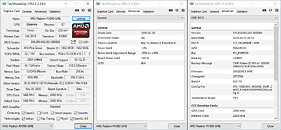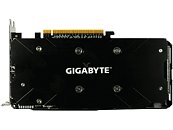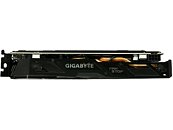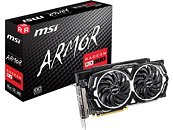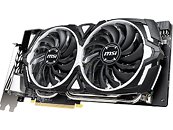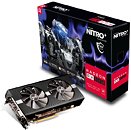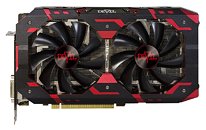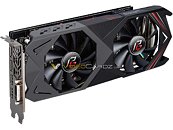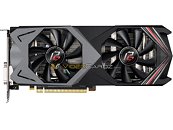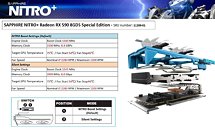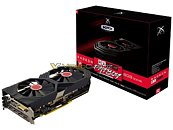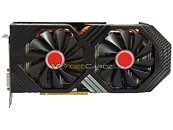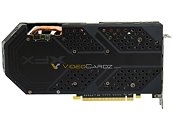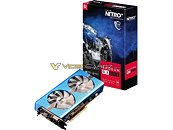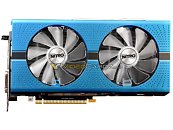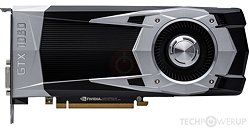Apr 10th, 2025 08:18 EDT
change timezone
Latest GPU Drivers
New Forum Posts
- Do you use Linux? (574)
- Asking before I mess up (19)
- Can you guess Which game it is? (66)
- Downgrading bios on asrock A320 board (4)
- TPU's Nostalgic Hardware Club (20215)
- Looking for input on fan placement for my Define R5 (10)
- Your PC ATM (35330)
- TechPowerUp RAM Latency Calculator Feedback (71)
- Problem "Vu meter Windows 11 24h2 missing" (2)
- Thermal testing two different size Gigabyte 5070 Ti cards - huge differences (20)
Popular Reviews
- The Last Of Us Part 2 Performance Benchmark Review - 30 GPUs Compared
- ASRock Z890 Taichi OCF Review
- MCHOSE L7 Pro Review
- Sapphire Radeon RX 9070 XT Pulse Review
- PowerColor Radeon RX 9070 Hellhound Review
- Upcoming Hardware Launches 2025 (Updated Apr 2025)
- Sapphire Radeon RX 9070 XT Nitro+ Review - Beating NVIDIA
- Acer Predator GM9000 2 TB Review
- ASUS GeForce RTX 5080 Astral OC Review
- Zotac GeForce RTX 5070 Ti Amp Extreme Review
Controversial News Posts
- NVIDIA GeForce RTX 5060 Ti 16 GB SKU Likely Launching at $499, According to Supply Chain Leak (174)
- MSI Doesn't Plan Radeon RX 9000 Series GPUs, Skips AMD RDNA 4 Generation Entirely (146)
- Microsoft Introduces Copilot for Gaming (124)
- AMD Radeon RX 9070 XT Reportedly Outperforms RTX 5080 Through Undervolting (119)
- NVIDIA Reportedly Prepares GeForce RTX 5060 and RTX 5060 Ti Unveil Tomorrow (115)
- Nintendo Confirms That Switch 2 Joy-Cons Will Not Utilize Hall Effect Stick Technology (100)
- Over 200,000 Sold Radeon RX 9070 and RX 9070 XT GPUs? AMD Says No Number was Given (100)
- Nintendo Switch 2 Launches June 5 at $449.99 with New Hardware and Games (99)
News Posts matching #RX 590
Return to Keyword Browsing
AMD ROCm 4.5 Drops "Polaris" Architecture Support
AMD's ROCm compute programming platform—a competitor to NVIDIA's CUDA, dropped support for the "Polaris" graphics architecture, with the latest version 4.5 update. Users on the official ROCm git raised this as an issue assuming it was a bug, to which an official AMD support handle confirmed that the Radeon RX 480 graphics card of the original poster is no longer supported. Another user tested his "Polaris 20" based RX 570, and it isn't supported, either. It's conceivable that the "Polaris 30" based RX 590, a GPU launched in November 2018, isn't supported either. Cutting out a 3-year old graphics architecture from the compute platform sends the wrong message, especially to CUDA users who AMD wants to win over with ROCm. With contemporary GPUs priced out of reach, IT students are left with used older-generation graphics cards, such as those based on "Polaris." NVIDIA CUDA supports GPUs as far back as "Maxwell" (September 2014).

AMD Radeon RX 590 GME is a Dressed Up RX 580: No more 12nm, Lower Performance
When AMD pushed out the Radeon RX 590 in late-2018, its key spec was that the "Polaris 20" die had been ported to GlobalFoundries 12LPP (12 nm) silicon fabrication node, yielding headroom to dial up clock speeds over the 14 nm RX 580. The underlying silicon was labeled "Polaris 30" as it was the second major version of the "Polaris 10" die. NVIDIA's GeForce GTX 16-series beat the RX 590 both in performance and price, with even the GTX 1650 Super performing on-par, and the GTX 1660 beating it. It turns out that AMD has a lot of unsold 14 nm "Polaris 20" inventory to go around, and it wants to release them out as the new RX 590 GME.
An Expreview review of an XFX-branded RX 590 GME confirms that the the chip is indeed based on the "Polaris 20 XTR" silicon which is built on the 14 nm process. The card has GPU clock speeds that appear similar to reference clock speeds of the RX 590, with 1460 MHz base compared to 1469 MHz of the original RX 590. But this is where the similarities end. In its testing, Expreview found that the RX 590 GME is on average 5% slower than the RX 590, and performs halfway between the RX 580 and the original RX 590, which are differentiated by a roughly 10% performance gap. The 5% performance deficit would put the RX 590 GME on par with the new RX 5500 XT 4 GB, and trading blows with the GTX 1650 Super. Thankfully, the RX 590 GME is priced lower than RX 590 cards (about 7.7% cheaper), and could be very region-specific. The fact that the RX 590 GME is being sold with full AIB partner branding and retail packaging, shows that this isn't an OEM-only product. Read the complete review in the source link below.
An Expreview review of an XFX-branded RX 590 GME confirms that the the chip is indeed based on the "Polaris 20 XTR" silicon which is built on the 14 nm process. The card has GPU clock speeds that appear similar to reference clock speeds of the RX 590, with 1460 MHz base compared to 1469 MHz of the original RX 590. But this is where the similarities end. In its testing, Expreview found that the RX 590 GME is on average 5% slower than the RX 590, and performs halfway between the RX 580 and the original RX 590, which are differentiated by a roughly 10% performance gap. The 5% performance deficit would put the RX 590 GME on par with the new RX 5500 XT 4 GB, and trading blows with the GTX 1650 Super. Thankfully, the RX 590 GME is priced lower than RX 590 cards (about 7.7% cheaper), and could be very region-specific. The fact that the RX 590 GME is being sold with full AIB partner branding and retail packaging, shows that this isn't an OEM-only product. Read the complete review in the source link below.

AMD Preparing New RX 590 GME Graphics Card for Release
Expreview has caught the sighting of an apparently upcoming AMD graphics card based around the RX 590 SKU. The new revision, being named the RX 590 GME, apparently features lower clocks than the base Polaris 30 RX 590 ~around 1,385 MHz boost compared to the vanilla RX590's 1545 MHz. That clockspeed puts the RX 590 GME slightly above the RX 580 in terms of specs, but way below the RX 590, which should lead to a distinct performance variation between the two.
It's unclear as to what GPU die this new Polaris-based graphics card will be using. If I were a betting man, I'd say these are being harvested from 12 nm Polaris 30 dies that haven't been able to sustain the 1545 MHz clockspeeds rated for RX 590 chips - but still being put to use and very likely with a better power/performance ratio than the RX 590. For now, the model is only available for pre-order through a Chinese e-tailer, which could mean this is a China-only release.
It's unclear as to what GPU die this new Polaris-based graphics card will be using. If I were a betting man, I'd say these are being harvested from 12 nm Polaris 30 dies that haven't been able to sustain the 1545 MHz clockspeeds rated for RX 590 chips - but still being put to use and very likely with a better power/performance ratio than the RX 590. For now, the model is only available for pre-order through a Chinese e-tailer, which could mean this is a China-only release.

Call of Duty: Modern Warfare System Requirements Revealed
Ahead of its October 25 release, NVIDIA got hold of the system requirements for "Call of Duty: Modern Warfare," the month's hottest AAA release. NVIDIA is an extensive technical partner for the game's development, and the game is expected to feature NVIDIA RTX real-time ray-tracing at launch, along with support for NVIDIA Highlights and Ansel, although there's no mention of DLSS from NVIDIA. The game supports Windows 7, and isn't restricted to Windows 10. It calls for a whopping 175 GB of disk space. The bare minimum system requirements for a 1080p experience includes 8 GB of RAM, Intel Core i3-4130 or AMD FX-6300 processors, and GeForce GTX 670 or current-gen GTX 1650 graphics.
The recommended system requirements for 1080p 60 FPS without ray-tracing are Core i5-2500K or Ryzen 5 1600X processor, 12 GB of RAM, and either GTX 970 or current-gen GTX 1660 graphics. For 1080p 60 FPS with ray-tracing, the requirements climb up to RTX 2060 graphics. At the same resolution with 144 FPS frame-rate, "High" preset, and "competitive" performance that won't let you down in an online MP situation, you'll need at least a GeForce RTX 2070 Super, 16 GB of system RAM, and either Core i7-8700K or Ryzen 7 1800X processor. For 4K 60 FPS with ray-tracing, a high-end experience, you'll need at least an RTX 2080 Super graphics card, and either Core i7-9700K or Ryzen 7 2700X processor. The NVIDIA article doesn't mention AMD Radeon graphics cards. In the absence of ray-tracing, you can probably use an RX 590 for 1080p 60 FPS, RX 5700 for 1080p 144 FPS or 1440p 60 FPS.
The recommended system requirements for 1080p 60 FPS without ray-tracing are Core i5-2500K or Ryzen 5 1600X processor, 12 GB of RAM, and either GTX 970 or current-gen GTX 1660 graphics. For 1080p 60 FPS with ray-tracing, the requirements climb up to RTX 2060 graphics. At the same resolution with 144 FPS frame-rate, "High" preset, and "competitive" performance that won't let you down in an online MP situation, you'll need at least a GeForce RTX 2070 Super, 16 GB of system RAM, and either Core i7-8700K or Ryzen 7 1800X processor. For 4K 60 FPS with ray-tracing, a high-end experience, you'll need at least an RTX 2080 Super graphics card, and either Core i7-9700K or Ryzen 7 2700X processor. The NVIDIA article doesn't mention AMD Radeon graphics cards. In the absence of ray-tracing, you can probably use an RX 590 for 1080p 60 FPS, RX 5700 for 1080p 144 FPS or 1440p 60 FPS.

AMD to Unveil Radeon RX 5500 on October 7
It turns out that the Radeon RX 5500 is arriving a lot sooner than expected, with VideoCardz reporting an October 7th product launch for the card. It's also being reported that the SKU will launch as the Radeon RX 5500 XT, with board partner GIGABYTE being ready with half a dozen custom-design cards, all of which with 8 GB of memory. In a separate report, VideoCardz also confirmed that the RX 5500 series will be based on the latest "Navi" family of GPUs that use the company's latest RDNA architecture, and will be built on the 7 nm silicon fabrication process. What's more, the RX 5500 will reportedly use 8 GB of modern GDDR6 memory across a 128-bit wide memory bus. A WCCFTech report predicts the RX 5500 (XT) will feature 22 RDNA compute units, which works out to 1,408 stream processors.
With these specs, we can see where AMD is going with the RX 5500 (XT). The company wants a viable successor to the Radeon RX 580 or even the RX 590, which it can sell around the $200-250 price-range, competing with a spectrum of NVIDIA GPUs, including the GeForce GTX 1650 and the GTX 1660. The card would target 1080p AAA gaming with high-thru-ultra settings, and 1080p eSports gaming at high refresh-rates. NVIDIA is already preparing a response to the RX 5500 in the form of the GTX 1650 Super and the GTX 1660 Super, which come with beefed up specs.
With these specs, we can see where AMD is going with the RX 5500 (XT). The company wants a viable successor to the Radeon RX 580 or even the RX 590, which it can sell around the $200-250 price-range, competing with a spectrum of NVIDIA GPUs, including the GeForce GTX 1650 and the GTX 1660. The card would target 1080p AAA gaming with high-thru-ultra settings, and 1080p eSports gaming at high refresh-rates. NVIDIA is already preparing a response to the RX 5500 in the form of the GTX 1650 Super and the GTX 1660 Super, which come with beefed up specs.

Sapphire To Launch Gold RX 590 Nitro+ for AMD's 50th Anniversary
Yes, we know that AMD's graphics division anniversary really isn't on its 50th year - ATI's acquisition, the true spirit behind AMD's graphics prowess, occurred back in 2006. However, that doesn't mean AMD's graphics aren't deserving of special commemorative editions. Sapphire have taken it upon themselves to celebrate the occasion with a gold-colored RX 590 graphics card.
The leak came over from one of my own homecountry's webshops, with a full product page that has since been taken down. There is no difference between this card and the usual blue RX 590 Nitro+ - the devil is in the color, so to say. Reference clocks remain the same at 1560 MHz core, and the cooling solution is the same. In Portuguese prices, the pricing difference seems to amount to some extra €25 for the limited edition graphics card. Whether the pricing difference is enough to warrant the additional investment should go according to your own mileage.
The leak came over from one of my own homecountry's webshops, with a full product page that has since been taken down. There is no difference between this card and the usual blue RX 590 Nitro+ - the devil is in the color, so to say. Reference clocks remain the same at 1560 MHz core, and the cooling solution is the same. In Portuguese prices, the pricing difference seems to amount to some extra €25 for the limited edition graphics card. Whether the pricing difference is enough to warrant the additional investment should go according to your own mileage.

GIGABYTE Rolls Out its Radeon RX 590 Gaming Graphics Card
That took a little while, but GIGABYTE has finally updated their lineup with an AMD RX 590 graphics card. Based on the 12 nm-revised Polaris 30 silicon with higher clocks than those that could be achieved by its 14 nm predecessors (already the RX 480 and RX 580 graphics cards), the GIGABYTE RX 590 Gaming rbings the already well-known 2304 Stream processors, and gets them to tick at 1560 MHz (against AMD's 1545 MHz reference). It's a usual GIGABYTE graphics card by all standards, with a dual-fan WindForce 2X cooling solution with fan-stop functionality.
It seems GIGABYTE finally went through some of that unsold RX inventory, and is now looking to keep the channel supplied until the next best thing from the red team makes its appearance (hopefully sooner rather than later.)
It seems GIGABYTE finally went through some of that unsold RX inventory, and is now looking to keep the channel supplied until the next best thing from the red team makes its appearance (hopefully sooner rather than later.)

AMD Releases Radeon Software Adrenalin 2019 Edition 19.2.2 Beta Drivers
AMD today made available the latest version of their Radeon software drivers, Adrenalin Edition 19.2.2, for supported graphics solutions. This brings with it support for the recently released Radeon VII graphics card, in addition to equally new and upcoming game titles including Metro Exodus, Far Cry New Dawn, the Civ VI: Gathering Storm expansion, and Crackdown 3. More pleasing to many users no doubt will be the large list of fixed issues, including a timely Alt + Tab shortcut on a DisplayPort monitor and plenty of bug fixes related to Radeon Wattman as it pertains to the Radeon VII. The drivers are up for download at the link below, hosted directly on TechPowerUp for your convenience, and the full change log is available past the break for those interested.
DOWNLOAD: AMD Radeon Software Adrenalin 19.2.2
DOWNLOAD: AMD Radeon Software Adrenalin 19.2.2

MSI Announces, Releases Its RX 590 Armor Graphics Card
This should be old news by now, but it actually isn't: MSI is just now releasing their iteration of the AMD Radeon RX 590 SKU. Perhaps the company decided that the product wasn't too differentiated from the previous RX 480 and RX 580 graphics cards so as to justify all the resources they'd have to pour through to its development; or they wanted to first sell through their RX 580 inventory, and have now struck a good balance with stocks of the old and the new.
Whatever the reason, the fact is that MSI's first RX 590, launched in the Armor series - it isn't even in the gaming X department - has been released, three months later, in two variants: Armor and Armor OC (the latter is running a paltry 20 MHz higher than the non-OC version, so). The 12 nm, Polaris 30 XT graphics card draws power from an 8-pin connector, and video outputs include 2x DisplayPort, 2x HDMI, and 1x DVI. It's a dual-slot affair, like almost all MSI graphics cards, and all Armor ones. No word as of yet on availability nor pricing.
Whatever the reason, the fact is that MSI's first RX 590, launched in the Armor series - it isn't even in the gaming X department - has been released, three months later, in two variants: Armor and Armor OC (the latter is running a paltry 20 MHz higher than the non-OC version, so). The 12 nm, Polaris 30 XT graphics card draws power from an 8-pin connector, and video outputs include 2x DisplayPort, 2x HDMI, and 1x DVI. It's a dual-slot affair, like almost all MSI graphics cards, and all Armor ones. No word as of yet on availability nor pricing.

NVIDIA Readies GeForce GTX 1660 Ti Based on TU116, Sans RTX
It looks like RTX technology won't make it to sub-$250 market segments as the GPUs aren't fast enough to handle real-time raytracing, and it makes little economic sense for NVIDIA to add billions of additional transistors for RT cores. The company is hence carving out a sub-class of "Turing" GPUs under the TU11x ASIC series, which will power new GeForce GTX family SKUs, such as the GeForce GTX 1660 Ti, and other GTX 1000-series SKUs. These chips offer "Turing Shaders," which are basically CUDA cores that have the IPC and clock-speeds rivaling existing "Turing" GPUs, but no RTX capabilities. To sweeten the deal, NVIDIA will equip these cards with GDDR6 memory. These GPUs could still have tensor cores which are needed to accelerate DLSS, a feature highly relevant to this market segment.
The GeForce GTX 1660 Ti will no doubt be slower than the RTX 2060, and be based on a new ASIC codenamed TU116. According to a VideoCardz report, this 12 nm chip packs 1,536 CUDA cores based on the "Turing" architecture, and the same exact memory setup as the RTX 2060, with 6 GB of GDDR6 memory across a 192-bit wide memory interface. The lack of RT cores and a lower CUDA core count could make the TU116 a significantly smaller chip than the TU106, and something NVIDIA can afford to sell at sub-$300 price-points such as $250. The GTX 1060 6 GB is holding the fort for NVIDIA in this segment, besides other GTX 10-series SKUs such as the GTX 1070 occasionally dropping below the $300 mark at retailers' mercy. AMD recently improved its sub-$300 portfolio with the introduction of Radeon RX 590, which convincingly outperforms the GTX 1060 6 GB.
The GeForce GTX 1660 Ti will no doubt be slower than the RTX 2060, and be based on a new ASIC codenamed TU116. According to a VideoCardz report, this 12 nm chip packs 1,536 CUDA cores based on the "Turing" architecture, and the same exact memory setup as the RTX 2060, with 6 GB of GDDR6 memory across a 192-bit wide memory interface. The lack of RT cores and a lower CUDA core count could make the TU116 a significantly smaller chip than the TU106, and something NVIDIA can afford to sell at sub-$300 price-points such as $250. The GTX 1060 6 GB is holding the fort for NVIDIA in this segment, besides other GTX 10-series SKUs such as the GTX 1070 occasionally dropping below the $300 mark at retailers' mercy. AMD recently improved its sub-$300 portfolio with the introduction of Radeon RX 590, which convincingly outperforms the GTX 1060 6 GB.

Sapphire Outs Radeon RX 590 Nitro+ OC Sans "Special Edition"
Sapphire debuted its Radeon RX 590 series last month with the RX 590 Nitro+ Special Edition, which at the time was advertised as a limited-edition SKU. The company over Holiday weekend updated its product stack to introduce a new mass-production SKU, the RX 590 Nitro+ OC, minus "Special Edition" branding. There are only cosmetic changes between the two SKUs. Sapphire's favorite shade of blue on the Special Edition SKU makes way for matte-black on the cooler shroud, as do the black accents on the back-plate, instead of blue. The fan impellers are opaque matte black instead of frosty and translucent.
Thankfully, Sapphire hasn't changed the specs that matter - factory-overclock. The card still ships with 1560 MHz engine clocks (boost), and 8.40 GHz (GDDR5-effective) memory, and a "quiet" second BIOS that dials down the clocks to 1545 MHz boost and 8.00 GHz memory. The underlying PCB is unchanged, too, drawing power from a combination of 8-pin and 6-pin PCIe power connectors, and conditioning it with a 6+1 phase VRM. Display outputs include two each of DisplayPort 1.4 and HDMI 2.0, and a dual-link DVI-D. The company didn't reveal pricing, although we expect it to be marginally lower than the Special Edition SKU.
Thankfully, Sapphire hasn't changed the specs that matter - factory-overclock. The card still ships with 1560 MHz engine clocks (boost), and 8.40 GHz (GDDR5-effective) memory, and a "quiet" second BIOS that dials down the clocks to 1545 MHz boost and 8.00 GHz memory. The underlying PCB is unchanged, too, drawing power from a combination of 8-pin and 6-pin PCIe power connectors, and conditioning it with a 6+1 phase VRM. Display outputs include two each of DisplayPort 1.4 and HDMI 2.0, and a dual-link DVI-D. The company didn't reveal pricing, although we expect it to be marginally lower than the Special Edition SKU.

ASUS Republic of Gamers Announces ROG Strix Radeon RX 590 Graphics Card
ASUS Republic of Gamers (ROG) today announced the ROG Strix Radeon RX 590, an all-new gaming graphics card powered by the latest AMD Radeon RX 590 GPU and engineered with advanced cooling, reliability, performance, and customizable lighting.
ROG Strix cards take cooling to the next level, keeping temperatures low and dB levels quiet. It starts with MaxContact technology, which uses precision machining to create a heat spreader surface that makes up to 2X more contact with the GPU chip, helping to improve thermal transfer. As heat passes into the heatsink, three powerful Wing-blade fans spin up when GPU temperatures exceed 55 Celsius. Wingblade fans are a patented design that offers 105% more static pressure than traditional axial designs, ensuring air is dispersed through the entire cooling array.
ROG Strix cards take cooling to the next level, keeping temperatures low and dB levels quiet. It starts with MaxContact technology, which uses precision machining to create a heat spreader surface that makes up to 2X more contact with the GPU chip, helping to improve thermal transfer. As heat passes into the heatsink, three powerful Wing-blade fans spin up when GPU temperatures exceed 55 Celsius. Wingblade fans are a patented design that offers 105% more static pressure than traditional axial designs, ensuring air is dispersed through the entire cooling array.

AMD Announces the Radeon RX 590 Graphics Card
You can find our launch-day reviews of the Radeon RX 590 here: Sapphire RX 590 Nitro+, XFX RX 590 Fatboy
AMD today unveiled the Radeon RX 590 graphics card, an advanced 12 nm GPU designed to deliver amazing gaming experiences and outstanding performance for the latest AAA, eSports and Virtual Reality (VR) titles.
Powered by AMD "Polaris" architecture, the AMD Radeon RX 590 graphics card provides faster clock speeds for higher gaming performance than the AMD Radeon RX 580 graphics card2, and delivers up to 20 percent or higher performance-per-dollar than the competition. Paired with the advanced AMD Radeon FreeSync gaming display technology and loaded with the latest AMD Radeon Software features, the AMD Radeon RX 590 graphics card delivers an exceptional gaming experience.
AMD today unveiled the Radeon RX 590 graphics card, an advanced 12 nm GPU designed to deliver amazing gaming experiences and outstanding performance for the latest AAA, eSports and Virtual Reality (VR) titles.
Powered by AMD "Polaris" architecture, the AMD Radeon RX 590 graphics card provides faster clock speeds for higher gaming performance than the AMD Radeon RX 580 graphics card2, and delivers up to 20 percent or higher performance-per-dollar than the competition. Paired with the advanced AMD Radeon FreeSync gaming display technology and loaded with the latest AMD Radeon Software features, the AMD Radeon RX 590 graphics card delivers an exceptional gaming experience.

AMD Radeon RX 590 Launch Price, Other Details Revealed
AMD is very close to launching its new Radeon RX 590 graphics card, targeting a middle-of-market segment that sells in high volumes, particularly with Holiday around the corner. The card is based on the new 12 nm "Polaris 30" silicon, which has the same exact specifications as the "Polaris 20" silicon, and the original "Polaris 10," but comes with significantly higher clock-speed headroom thanks to the new silicon fabrication process, which AMD and its partners will use to dial up engine clock speed by 10-15% over those of the RX 580. While the memory is still 8 Gbps 256-bit GDDR5, some partners will ship overclocked memory.
According to a slide deck seen by VideoCardz, AMD is setting the baseline price of the Radeon RX 590 at USD $279.99, which is about $50 higher than RX 580 8 GB, and $40 higher than the price the RX 480 launched at. AMD will add value to that price by bundling three AAA games, including "Tom Clancy's The Division 2," "Devil May Cry 5," and "Resident Evil 2." The latter two titles are unreleased, and the three games together pose a $120-150 value. AMD will also work with monitor manufacturers to come up with graphics card + AMD FreeSync monitor bundles.
According to a slide deck seen by VideoCardz, AMD is setting the baseline price of the Radeon RX 590 at USD $279.99, which is about $50 higher than RX 580 8 GB, and $40 higher than the price the RX 480 launched at. AMD will add value to that price by bundling three AAA games, including "Tom Clancy's The Division 2," "Devil May Cry 5," and "Resident Evil 2." The latter two titles are unreleased, and the three games together pose a $120-150 value. AMD will also work with monitor manufacturers to come up with graphics card + AMD FreeSync monitor bundles.

PowerColor Announces the AMD Radeon Red Devil RX 590 8GB GDDR5 Graphics Card
TUL Corporation, a leading and innovative manufacturer of AMD graphic cards since 1997, has introduced the newest PowerColor Red Devil RX 590 8GB GDDR5. The new Red Devil RX 590 brings new blood to the mainstream market, performing more than 10% over the comparable priced cards, this makes a no brainer for this segment.
It is powered by AMD's newest gaming RX590 GPU built on 12 nm, offering the best 1080p performance at the highest settings with uncompromised graphic details. Red Devil RX 590 improves on efficiency, having a boost clock of 1576 MHz core clock speed which is 17% clock speed increase over the 580 at no power consumption increase.
It is powered by AMD's newest gaming RX590 GPU built on 12 nm, offering the best 1080p performance at the highest settings with uncompromised graphic details. Red Devil RX 590 improves on efficiency, having a boost clock of 1576 MHz core clock speed which is 17% clock speed increase over the 580 at no power consumption increase.

HIS Radeon RX 590 IceQ X² Detailed
With a little Javascript trickery, Redditor "BadReIigion" succeeded in making the company website of AMD partner HIS to spit out details of its upcoming Radeon RX 590 IceQ X² graphics card (model number: HIS-590R8LCBR). Pictured below is the RX 580 IceQ X², but we expect the RX 590-based product to be mostly similar, with cosmetic changes such as a different cooler shroud or back-plate design. The website confirms some details like the ASIC being "Polaris 30 XT," a rendition of the 2,304-SP "Polaris 20" die on the 12 nm FinFET node, and that the card features 8 GB of GDDR5 memory. Some of the other details, such as the engine clock being mentioned as "2000 MHz" is unlikely.
The consensus emerging on engine clock boost frequencies from RX 590 leaks so far, put RX 590 custom-design, factory-overclocked cards to tick around 1500-1550 MHz, a 100-200 MHz improvement over the RX 580. Some board vendors such as Sapphire are even overclocking the memory by about 5%. "Polaris 30" is likely pin-compatible with "Polaris 20," because most board vendors are reusing their RX 580 PCBs, some of which are even carried over from the RX 480. For the HIS RX 590 IceQ X² this means drawing power from a single 8-pin PCIe power connector.
The consensus emerging on engine clock boost frequencies from RX 590 leaks so far, put RX 590 custom-design, factory-overclocked cards to tick around 1500-1550 MHz, a 100-200 MHz improvement over the RX 580. Some board vendors such as Sapphire are even overclocking the memory by about 5%. "Polaris 30" is likely pin-compatible with "Polaris 20," because most board vendors are reusing their RX 580 PCBs, some of which are even carried over from the RX 480. For the HIS RX 590 IceQ X² this means drawing power from a single 8-pin PCIe power connector.

ASRock Radeon RX 590 Phantom Gaming Pictured
Here are some of the first pictures of ASRock Radeon RX 590 Phantom Gaming graphics card, based on AMD's upcoming "Polaris 30" silicon, which is an optical shrink of the "Polaris 20" silicon to 12 nm FinFET process, letting AMD and its partners increase GPU clock speeds. The RX 590 Phantom Gaming features a similar board design to the RX 580 Phantom Gaming X, with subtle design changes to its cooler shroud. The card still draws power from only a single 8-pin PCIe power connector. The VideoCardz article with these pictures doesn't mention clock-speeds, although going by trends, the RX 590 could be clocked well above 1500 MHz out of the box, compared to 1445 MHz of the RX 580 Phantom Gaming X in "OC mode."

Sapphire Radeon RX 590 NITRO+ Special Edition Detailed
Sapphire is developing a premium variant of its upcoming Radeon RX 590 series, called the RX 590 NITRO+ Special Edition, much like the "limited edition" branding it gave its premium RX 580-based card. Komachi Ensaka accessed leaked brochures of this card, which will bear an internal SKU code 11289-01. The brochure also confirms that the RX 590 features an unchanged 2,304 stream processor count from the RX 580, and continues to feature 8 GB of GDDR5 memory across a 256-bit wide memory interface. All that's new is improved thermals from a transition to the new 12 nm FinFET silicon fabrication process.
The Sapphire RX 590 NITRO+ SE ships with two clock-speed profiles, that can be probably toggled on the hardware by switching between two BIOS ROMs. The first profile is called NITRO+ Boost, and it runs the GPU at 1560 MHz, and the memory at 8400 MHz (GDDR5-effective). The second profile, called Silent Mode, reduces the engine clock boost to 1545 MHz, and the memory to 8000 MHz. For both profiles, the fan settings are unchanged. The fans stay off until the GPU is warming up to 54 °C, and spins at its nominal speed at 75 °C. It cuts off at 45 °C. The nominal speed is 0 - 2,280 RPM and the maximum speed is 3200 RPM.
The Sapphire RX 590 NITRO+ SE ships with two clock-speed profiles, that can be probably toggled on the hardware by switching between two BIOS ROMs. The first profile is called NITRO+ Boost, and it runs the GPU at 1560 MHz, and the memory at 8400 MHz (GDDR5-effective). The second profile, called Silent Mode, reduces the engine clock boost to 1545 MHz, and the memory to 8000 MHz. For both profiles, the fan settings are unchanged. The fans stay off until the GPU is warming up to 54 °C, and spins at its nominal speed at 75 °C. It cuts off at 45 °C. The nominal speed is 0 - 2,280 RPM and the maximum speed is 3200 RPM.

XFX Radeon RX 590 Fatboy Smiles For The Camera
The flood of leaked AMD Radeon RX 590 graphics cards continues with the latest one being from XFX. Sporting a new naming scheme, the XFX Radeon RX 590 Fatboy is very similar to the RX 580 GTS series. It features the same dual fan cooler used on the RX 580 GTS, which takes up roughly 2.5 slots. Even the backplate remains the same with no changes to speak of, meaning side by side you wouldn't be able to tell the difference unless you look at power delivery which is where the designs diverge. The RX 590 Fatboy utilizing an 8+6 pin design compared to the RX 580 GTS series and its single 8-pin design. In regards to display outputs that remains the same between the two with three DisplayPorts, one HDMI port, and one DVI-I port being standard.
When it comes to clock speeds the XFX RX 590 Fatboy OC+ at least according to Videocardz will come with a 1600 MHz boost clock. That is an increase of roughly 200 MHz over XFX's highest clocked RX 580. With such a high boost clock the additional 6-pin power connector is likely included for improved power delivery and depending on luck may allow for more overclocking headroom. Considering no vendor releases just one version of a graphics card it is likely that a few more variants will be available at launch. Sadly no pricing information is available as of yet.
When it comes to clock speeds the XFX RX 590 Fatboy OC+ at least according to Videocardz will come with a 1600 MHz boost clock. That is an increase of roughly 200 MHz over XFX's highest clocked RX 580. With such a high boost clock the additional 6-pin power connector is likely included for improved power delivery and depending on luck may allow for more overclocking headroom. Considering no vendor releases just one version of a graphics card it is likely that a few more variants will be available at launch. Sadly no pricing information is available as of yet.

Sapphire Radeon RX 590 NITRO+ Special Edition Spotted
As the expected November 15th release date for AMD's Radeon RX 590 inches closer, more leaks of AIB cards have started trickling in. Sapphire's Radeon RX 590 NITRO+ is just the latest to appear. Much like the ASUS ROG STRIX version leaked earlier, Sapphire design is using a hefty cooler for what amounts to a mid-range graphics card. The design looks to be the exact same as their RX 580 NITRO+ with just a fresh coat of paint to spruce things up. They are using the same shroud, dual fans, large aluminum heatsink, and full cover backplate on both graphics cards. That said, the change to a bright blue shroud gives the RX 590 NITRO+ a unique appearance that should at the very least help it stand out against its more mundane black and white designs of the competition.
In regards to actual specifications, the RX 590 features the same 2304 Stream processors, 144 TMUs (texture mapping units), and 32 ROPS (render output units) as the RX 580. This is because the Polaris 30 design used in the RX 590 is just a die shrink of Polaris 20 used in the RX 580. Obviously with a die shrink typically comes improved performance, usually via higher clock speeds. Currently, the final clock speeds for Sapphire's Radeon RX 590 NITRO+ are not known. However, if the rumored reference boost clock of 1545 MHz is correct, an overclock pushing that a step further is likely. Meaning performance should be improved compared to what we have seen in variousleaks thus far.
In regards to actual specifications, the RX 590 features the same 2304 Stream processors, 144 TMUs (texture mapping units), and 32 ROPS (render output units) as the RX 580. This is because the Polaris 30 design used in the RX 590 is just a die shrink of Polaris 20 used in the RX 580. Obviously with a die shrink typically comes improved performance, usually via higher clock speeds. Currently, the final clock speeds for Sapphire's Radeon RX 590 NITRO+ are not known. However, if the rumored reference boost clock of 1545 MHz is correct, an overclock pushing that a step further is likely. Meaning performance should be improved compared to what we have seen in variousleaks thus far.

AMD Radeon RX 590 Built on 12nm FinFET Process, Benchmarked in Final Fantasy XV
Thanks to some photographs by Andreas Schilling, of HardwareLuxx, it is now confirmed that AMD's Radeon RX 590 will make use of the 12 nm FinFET process. The change from 14 nm to 12 nm FinFET for the RX 590 brings with it the possibility of both higher clock speeds and better power efficiency. That said, considering it is based on the same Polaris architecture used in the Radeon RX 580 and 570, it remains to be seen how it will impact AMDs pricing in regards to the product stack. Will there be a price drop to compensate, or will the RX 590 be more expensive? Since AMD has already made things confusing enough with its cut down 2048SP version of RX 580 in China, anything goes at this point.

ASUS Prepares GPP-Ridden Radeon RX 590 ROG STRIX Graphics Card for Launch
Videocardz, through their industry sources, say they've confirmed that ASUS is working on their own Radeon RX 590 ROG STRIX graphics card. The naming isn't a typo: the GPP-fueled AREZ moniker has apparently gone off the window for ASUS by now, and the RX 590 should be marketed under its (again) brand-agnostic ROG lineup. The product code (ASUS Radeon RX 590 ROG STRIX GAMING (ROG-STRIX-RX590-8G-GAMING) indicates the usage of 8 GB of graphics memory just like the RX 580, and we all expect this to be of the GDDR5 kind with no further refinements. It's all in the die, as they (could) say.

NVIDIA Rushes in GTX 1060 with GDDR5X to Counter AMD Radeon RX 590 Threat
AMD is giving final touches to its Radeon RX 590 graphics card, which is rumored to be based on an efficient new rendition of the "Polaris" silicon, which could disturb NVIDIA's product lineup between the GTX 1060 series and the GTX 1070, as its new RTX 2060 series is nowhere in sight. In a bid to thwart this threat, NVIDIA is preparing a variant of the GeForce GTX 1060 with faster GDDR5X memory.
The current GTX 1060 6 GB is endowed with 8 Gbps GDDR5 memory, which at its 192-bit bus width works out to a memory bandwidth of 192 GB/s. NVIDIA had attempted to improve its competitive position once, by creating a shortlived sub-variant of this SKU with 9 Gbps GDDR5 memory (211 GB/s). Switching to 10 Gbps GDDR5X memory would give the chip 240 GB/s memory bandwidth, and 11 Gbps (unlikely because expensive), would yield 264 GB/s. With the GP106 silicon maxed out, it's also possible the new GTX 1060 could be based on a heavily cut down GP104, possibly even with 192-bit memory, which explains GDDR5X memory.
The current GTX 1060 6 GB is endowed with 8 Gbps GDDR5 memory, which at its 192-bit bus width works out to a memory bandwidth of 192 GB/s. NVIDIA had attempted to improve its competitive position once, by creating a shortlived sub-variant of this SKU with 9 Gbps GDDR5 memory (211 GB/s). Switching to 10 Gbps GDDR5X memory would give the chip 240 GB/s memory bandwidth, and 11 Gbps (unlikely because expensive), would yield 264 GB/s. With the GP106 silicon maxed out, it's also possible the new GTX 1060 could be based on a heavily cut down GP104, possibly even with 192-bit memory, which explains GDDR5X memory.

Alleged AMD RX 590 3D Mark Time Spy Scores Surface
Benchmark scores for 3D Mark's Time Spy have surface, and are purported to represent the performance level of an unidentified "Generic VGA" - which is being identified as AMD's new 12 nm Polaris revision. The RX 590 product name makes almost as much sense as it doesn't, though; for one, there's no real reason to release another entire RX 600 series, unless AMD is giving the 12 nm treatment to the entire lineup (which likely wouldn't happen, due to the investment in fabrication process redesign and node capacity required for such). As such, the RX 590 moniker makes sense if AMD is only looking to increase its competitiveness in the sub-$300 space as a stop-gap until they finally have a new graphics architecture up their shader sleeves.
Apr 10th, 2025 08:18 EDT
change timezone
Latest GPU Drivers
New Forum Posts
- Do you use Linux? (574)
- Asking before I mess up (19)
- Can you guess Which game it is? (66)
- Downgrading bios on asrock A320 board (4)
- TPU's Nostalgic Hardware Club (20215)
- Looking for input on fan placement for my Define R5 (10)
- Your PC ATM (35330)
- TechPowerUp RAM Latency Calculator Feedback (71)
- Problem "Vu meter Windows 11 24h2 missing" (2)
- Thermal testing two different size Gigabyte 5070 Ti cards - huge differences (20)
Popular Reviews
- The Last Of Us Part 2 Performance Benchmark Review - 30 GPUs Compared
- ASRock Z890 Taichi OCF Review
- MCHOSE L7 Pro Review
- Sapphire Radeon RX 9070 XT Pulse Review
- PowerColor Radeon RX 9070 Hellhound Review
- Upcoming Hardware Launches 2025 (Updated Apr 2025)
- Sapphire Radeon RX 9070 XT Nitro+ Review - Beating NVIDIA
- Acer Predator GM9000 2 TB Review
- ASUS GeForce RTX 5080 Astral OC Review
- Zotac GeForce RTX 5070 Ti Amp Extreme Review
Controversial News Posts
- NVIDIA GeForce RTX 5060 Ti 16 GB SKU Likely Launching at $499, According to Supply Chain Leak (174)
- MSI Doesn't Plan Radeon RX 9000 Series GPUs, Skips AMD RDNA 4 Generation Entirely (146)
- Microsoft Introduces Copilot for Gaming (124)
- AMD Radeon RX 9070 XT Reportedly Outperforms RTX 5080 Through Undervolting (119)
- NVIDIA Reportedly Prepares GeForce RTX 5060 and RTX 5060 Ti Unveil Tomorrow (115)
- Nintendo Confirms That Switch 2 Joy-Cons Will Not Utilize Hall Effect Stick Technology (100)
- Over 200,000 Sold Radeon RX 9070 and RX 9070 XT GPUs? AMD Says No Number was Given (100)
- Nintendo Switch 2 Launches June 5 at $449.99 with New Hardware and Games (99)




